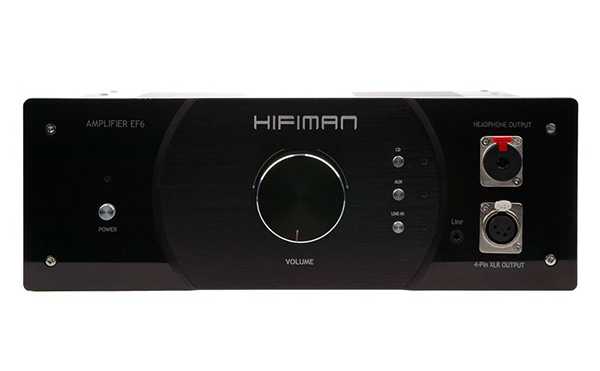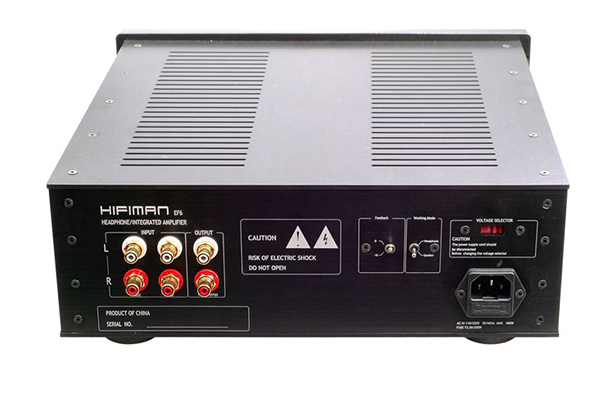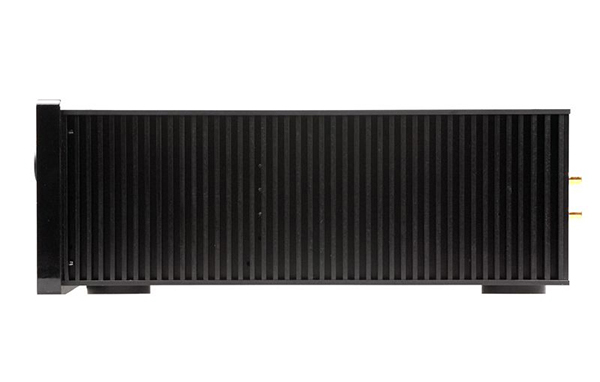The Hifiman EF6 is a Class A high-end solid-state desktop amplifier specifically tuned and powered to pair with the HE6 headphones. It is priced at $1599.
Disclaimer: The Hifiman EF6 sent to us is a sample in exchange for our honest opinion. We thank the team at Hifiman for giving us this opportunity.
To read more about Hifiman products we have reviewed on Headfonics click here.
What’s in a single number change? Moving from 5 to 6 should be an evolution of sorts, I mean the EF5 was a pretty powerful little tube amp that packed about 2.5W per channel and took little or no space in 2011.
But that was then and this is now and the world of planers has moved onto balanced beasts such as the Mjolnir and even moved the game into portable powerhouses such as the ALO Audio RX MK3 in balanced mode.
What was great then is just ok now and we can virtually thank the Hifiman HE6 and the Audeze LCD-2 for driving the whole power amplification market to what it is today.
The Response
The EF6 is Hifiman’s big response ironically to its own creation the HE6 planer and is designed to match the needs and tonality of the HE6 which, given the right 3rd party amp, can sound wonderfully smooth and possesses huge scalability potential, frighteningly so actually.
Let me tell you in the flesh the EF6 is nothing like the EF5. This is a totally different beast and frankly one of the biggest headphone amps I have ever laid eyes on. I think it is even bigger than my old Denon 3 series integrated amplifier and weighs a ton also. I dunno I feel satisfyingly excited and assured the power might be there seeing something that big on my desktop purely for headphones.
Tech Inside
The EF6 is a 10-kilo pure class A transistor circuit headphone amp. No push and pull, no hybrid technology stuck in there coloring and adjusting the flavor.
Sporting a ‘hand-made’ 24 step attenuator and that all-important 5 watts per channel this is the flagship amp for power, the soul mate for planers and perhaps, just perhaps, a problem solver for any inefficient driver masquerading as a regular headphone (hello AKG).
Perhaps the peculiar aspect of such a behemoth though is the single-ended circuity tucked inside the black casing.
No balanced mode? Yes, that is correct the EF6 is a single-ended unbalanced setup even though some might be fooled by the 4 pin XLR output on the front plate the input at the back is RCA only. Yes, the EF6 can double up as a pre-amp with the dual RCA input and single RCA output on the back as well as a single line-in on the front plate but balanced mode it does not do sadly.
Since it retails for around $1600 I felt it should have had a balanced circuitry option in there somewhere. It certainly is big enough to carry one and quite a lot of planers these days have either been re-cabled in balanced mode or come with a balanced mode option such as the Bryston BHA-1 and the Schiit Mjolnir (considerably cheaper also than the EF6).
Attenuator
Front and center we have the 24-step custom made attenuator (volume knob in case you pause for thought) which although superior to the Alps pot variant does sometimes lends itself open to concerns from a few that accurate volume setting is not possible.
Having used the Burson stepped attenuator on the HA-160 for the best part of 2 years with relative ease I found the EF6 attenuator to be pretty accurate though and a small minor adjustment at the source level was perhaps quicker for varying levels of source volume levels rather than minute fiddling with the amp controls.
Added to that stepped attenuators have better left and right balancing than regular volume pots with higher quality resistors being used.
Inputs & Outputs
To the left, we have the single power on and off button and to the right, we have the three source selectors – CD, Aux, and line-in. Then the single-ended clamp jack and XLR can input to the far right.
Being a solid-state class A powering up the amp was effortless, smooth and surprisingly, after extended listing periods, relatively cool to the physical touch, unlike some other class A amps or planer orientated amps such as the Lyr which sometimes you could fry an egg on after 30 minutes use.
To the rear we have that singled RCA setup, I spoke about earlier with dual input RCA’s and then single pre-amp output. Apart from that, you have a voltage switch, AC and a simple high/low gain switch which is normally in my testing time used at the low-level setting except for the HE6 and LCD-2.
Sound Impressions
Summary
Being a headphone guy I decided to throw both the Gungnir DAC and the Rein Audio X3 DAC into both source outputs and give the EF6 a workout using naturally a HE6 but throwing in a LCD-2 Rev 2 and a HD700 to see how it could perform and also I had half an eye on the AKG K500 and 501 to see what it made of regular mortal but evil dynamic cans that are usually hard to drive.
The EF6 tonality can be best described as, well, almost a perfect match for the HE6 with a beautifully clean and neutral tonality that is not too aggressive or forward but neither too laid back to lacking in any dynamics that could class it as a “boring” amp.
The Rein X3 would have a small role in this being a very controlled DAC but lacking in any hyperdynamic impact but not so much as to change the amp core balanced tonality to any significant extent. I was expecting top-end articulation bordering on sizzling or a distinctly tuned bottom end or something but this beautiful balance in presentation and color makes the EF6 for me, not just a powerful planer friendly amp but incredibly versatile also.
Synergy
DACs
Switching from Rein X3 to the Gungnir increased the dynamics considerably but that wonderful smooth rounded presentation stayed true and firm with the HE6. Zero distortion and a full rich tonality without a hint of top-end zing. Just wonderful, if you ask me and edges out the Mjolnir for smoothness.
The Mjolnir might on paper have a balanced 10w capability but its more strident and slightly brighter presentation can sound a bit harsher than the treacle smooth EF6. I remember when I first bought the HE6 and paired it with the EF5 and my overall impression was of a great headphone but perhaps a bit thin and bright compared to the LCD-2 and true enough most guys I know opted for the easier to drive LCD-2 but I stuck with my HE6.
Something said to me this baby can scale with the right amp and with the EF6 my gut instinct proves totally spot on. Gone is the sharpness and in comes a super lush soundscape that I can honestly say is perhaps the most engaging and relaxing I have ever experienced with the HE6 with any amplifier.
It won’t change the HE6 core monitor like quality, it won’t give you oodles of bass or an attenuated top it and thank God for that, it simply smooths everything out a touch and brings it all together into a transparent but wonderfully coherent sound.
Note for power purposes the HE6 was hitting 1pm on the dial with a source to spdif to the Gungnir DAC which is a bit higher than the balanced Mjolnir which rarely ever gets above 12 noon.
Audeze LCD-2
Moving to the LCD-2 rev 2 and dropping the attenuator down about 2 steps that transparent but smooth quality of the EF6 shone through quickly enough. The LCD-2 rev 2 was engaging, impactful and hit deep, very deep indeed though to be honest I felt the HE6 tonally matched slightly better than the LCD-2 with a touch more clarity at the top end and slightly less forward monitor like quality that I tend to prefer.
I have to admit though if being played to their strengths, the LCD-2 for that visceral rock and bass and the HE6 for that articulation and wonderful coherence are both very compelling amped though the EF6.
Sennheiser HD700
I also starting liking the HD700 a bit more than I used to with the EF6. That crazy wacky treble of the HD700 calmed down a little with the lusher EF6 tonality making it a much less fatiguing headphone than I remembering it being running it from the likes of my older Burson HA-160 and the EF5.
Low and behold the AKG K501/500 had no issues at all being driven from the EF5 – a meatier bass and better extension at the top end for the K501 and a slightly thicker sounding presentation for the K500.
Select Comparisons
Most looking at the EF6 will have had a second glance also at the Mjolnir at almost half the price and of course the budget EF5 and Lyr with their various tube and hybrid qualities thinking that there might be a serious saving to be made.
Outside of the Mjolnir you can save the cash with the others but you just won’t get any serious degree of smoothness. The Mjolnir would be the closest for power though tonally its a bit brighter and more dynamic than the EF6.
Some will prefer that and for initial listening impressions the Mjolnir will resonate the faster but for long term listening the EF6 tonally has that edge in refinement for me. Yes, you can power up to the new Studio Six from ALO Audio and the Dark Star at almost 3 times the cost but the EF6 sits just about right for me in terms of sound and price for the HE6.
Final Words
The EF6 is $1600 well spent if you are after a powerful amplifier for your planers and inefficient dynamic cans. What surprised me most was the wonderfully lush and smooth sounding presentation particularly when paired with the HE6. Not a thin sharp notes and a much more engaging sound that reeks of quality when those two are matched. The LCD-2 sounded great also but you can tell the tuning was done with the HE6 in mind.
On paper, some might pick the Mjolnir over the EF6 due to the balanced output thinking that will make the bigger difference but I think they will lose out a bit since tonally I think the EF6 is the true pick.
Hifiman HE6 Technical Specifications
- Volume: Hand-made Step Attenuator
- Power Supply Design: CLC filter
- Weight: about 24 lb (10.75 KG)
- Dimensions: 13”(330 mm)Wide *12.2″(310mm)Deep *4.1″(105mm)High
- THD: 0.03% (1w and 1KHz)
- S/N: 95 DB
- Max Output: Class A 5W at 50 Ohm







